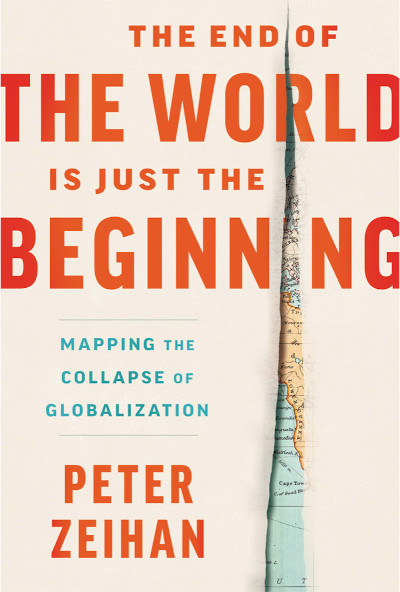In the picture
Book cover of Peter Zeihan's book 'The End of the World Is Just the Beginning. Mapping the Collapse of Globalization' (New York: Harper Business, 2022) 497 pages.
Many warn of the coming de-globalization, but very few imagine it in detail. Peter Zeihan details in almost five hundred pages what the world will be like once globalization collapses: these are not 'imaginations', he assures, but the result of a serious process of prospective analysis. Zeihan has been involved in geopolitical strategy for some time - he was at Stratfor and then went independent with his own signature - and his three previous books have all pointed in the same direction ('The Accidental Superpower', 'The Absent Superpower' and 'Disunited Nations').
Zeihan bases all his elaborations on two pillars: (1) the United States no longer needs the rest of the world or some of its regions in particular (on the one hand, fracking gives it energy independence, and on the other, it no longer has a planetary military enemy that forces it to seek alliances as when it faced the USSR); (2) the withdrawal of the US will leave the seas without custody and this will mean the end of the global scale trade that has been expanding since 1945.
deadline In previous books, as their titles indicate, Zeihan has been delving into the medium and long term consequences of the new reality of the USA as an 'absent superpower' (a world preeminence, on the other hand, achieved in an 'accidental' way, since it is based on geography) and whose absence will fracture relations between countries and increase their conflicts.
In his new production, Zeihan 'maps' a de-globalized globe: he examines what specific consequences - and for which countries - the collapse of long-range transport and intercontinental supply chains will have and projects the impact this will have on access to energy and industrial materials. These aspects, along with demographics, provide clues as to what the new era will look like in terms of manufacturing production. Couple this with climate change and you have a picture of what will happen in the field of agriculture and food, which is absolutely critical.
Although mentioned in the previous paragraph almost in passing, demographics is one of the basic vectors in Zeihan's analysis. Negative demographics in many countries (notably in China and Russia, but also in the European Union; in contrast, the US has a healthier birth rate, with a less pronounced decline) heralds that the world as a whole will see reduced consumption and slower economic growth, as well as less capital generation.
The demographic collapse in which China finds itself, with a labor force that has already begun to contract, and the difficulties that country will have to supply itself with everything it needs in the status disruption of the "new age" trade routes (it needs to import energy and food in large Issue) lead Zeihan to strongly predict China's collapse in a few years. Its urbanization and industrialization were so rapid, that the fees of birth collapsed very fast; faster still was its aging and will be its collapse: "The numbers tell us that it must happen in this decade".
On the other hand, the US appears to be the country in the best position status to face the new era: with sufficient energy and resources of its own, without the need for inter-oceanic trade because it will be able to source what it does not have in Latin America, and with a demographic that is better prepared (the US baby boomers were not only the largest generation compared to their peers in other countries, but also the ones who had the most children), which is being helped by immigration.
Europe remains at an intermediate status , which, according to Zeihan, will be divided into different areas of influence, led by the United Kingdom, France, Germany and Sweden, with Russia and Turkey on the margins. Japan will emerge as the main power in Northeast Asia, while Southeast Asia, with Australia's partnership , will be able to maintain its position as a manufacturing center.
But Zeihan's description of the world to come in the remainder of the 2020s and the 2030s is not just a 'power game'. His prediction affects millions of people: most of the planet will lack products that are now commonplace and those that can be produced or imported will become more expensive; some technologies will no longer be accessible, and hunger will spread to many places. He warns that we are not really facing 'de-globalization', or even 'de-industrialization', but 'de-civilization'.
Zeihan allows himself an occasionally jocular tone (in tune with the rigorous nonchalance he uses in his informative videos), which it is not clear that it matches the gloomy perspective he presents (he speaks, among other calamities, of several million deaths from starvation), although he claims to do so to avoid falling into a collective depression. It is surprising that he can really see the future with such precision (what will happen to chicken meat or lead production in two decades, for example).
The book may seem like an attempt to exaggerate so that we wake up from the mirage in which we live and accept that we have reached a maximum of generalized development in the world and that in most countries nothing will be like the miraculous last three decades. The point is that Zeihan believes in his method of study and all that he anticipates through it. We must recognize that many of the projections he has made so far have come true (more in general lines than in detail, although not infrequently also in specifics). Who would have bought him a couple of years ago the problems in the supply chains that we are now experiencing or the rapid economic slowdown in China that we are witnessing month after month?

